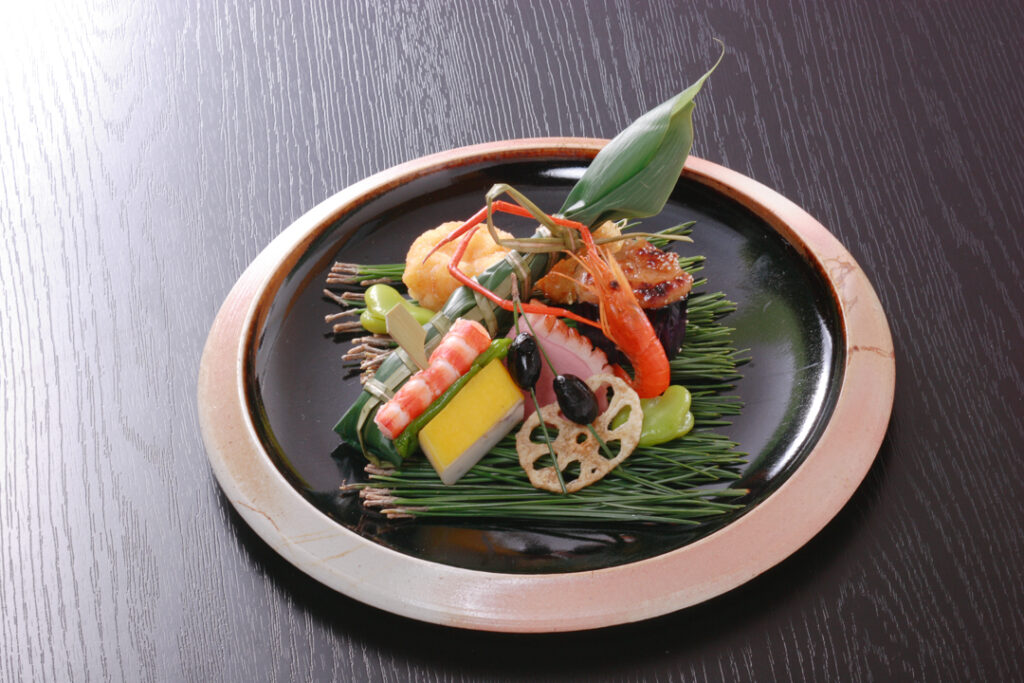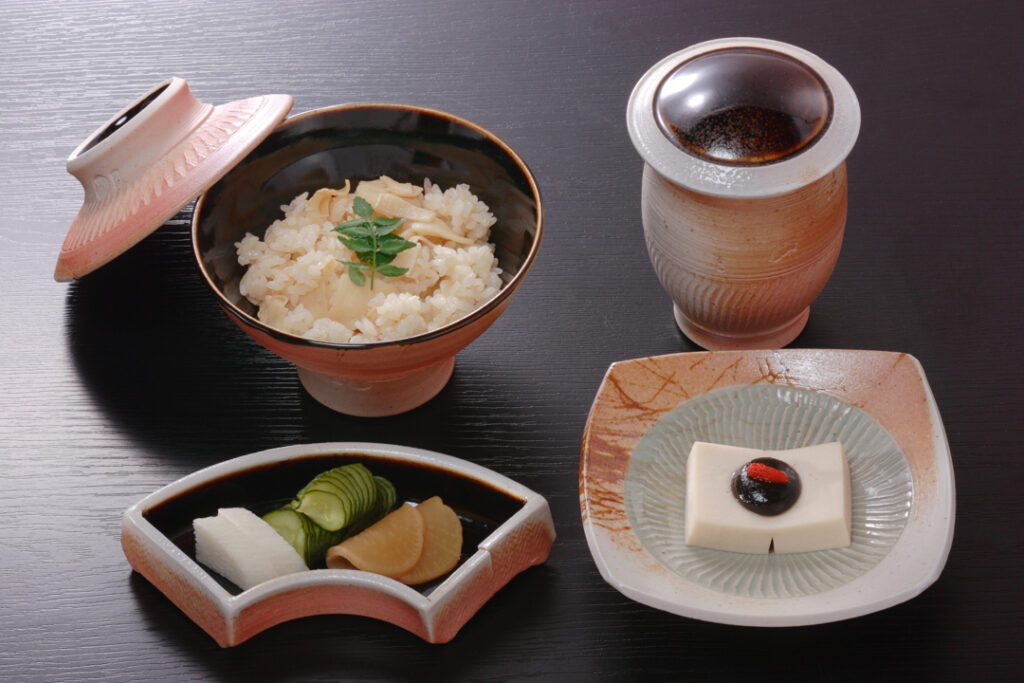Euan Craig shares his life at the wheel in a Japanese pottery village, where he makes tableware that helps savour the food and its moment.
The white teeth of the Mikuni Range are bared against a stormy sky, and the biting wind that blows from them carries “Yuki arare”, small clumps of crystal snow no bigger than a match head. The snow whispers across the frosted glass as I sit by the window in the soft morning light, the trundle of the kick wheel and the padding of my bare foot on the polished wood muttering into the shadows of the studio. The clay nuzzles against my hands like a cold, wet cat, flowing into the still spaces between my fingers. It transforms into a small plate, its surface rippled with the memory of my touch. I measure it once, touching the wing tips of my dragonfly tool to its edges, then cut it from the wheel with the flick of a thread, move it to the board beside its siblings, and start again. When they are finished, each vessel will tell the story of its creation, every touch of a finger, stroke of a tool and lick of wood flame, an expression of the interaction of the potter and the forces of nature, given form in clay. But there is an expectant space within them, waiting for another voice to turn the story into a conversation. As each vessel forms on the wheel, I am aware that I am not making pots…I am making dinner.
My understanding of this relationship began in November 1993. I had not long finished my apprenticeship under Tatsuzo Shimaoka in Mashiko within the Mingei discipline, and was given the opportunity to have my first solo exhibition in Tokyo by Masahiro Miyake, the ninth-generation proprietor of Ebiya Bijutsuten, a dealer in antiquities. Ebiya Bijutsuten was established in Kyoto in 1673, and moved to Nihonbashi, Tokyo, with the Meiji Emperor at the start of the Meiji period as a purveyor to the imperial household. Miyake-san’s intention was to nurture contemporary artists and craftspeople, building on tradition and creating a new body of future antiquities.
- Euan Craig – Euan Craig, Chattered Celadon Sashimi Plate, 2008, wood fired porcelain blend, 50mm x 180mm x 180mm
- Euan Craig – Euan Craig, Handled Bowl, 2006, wood fired porcelain blend, 1500mm x 150mm x 150mm
- Euan Craig – Euan Craig, Tenmoku Triangle Plate, 2006, wood fired porcelain blend, 30mm x 210mm x 210mm
- Euan Craig – Euan Craig,Tripod Bowl, 2006, wood fired porcelain blend, 70mm x 180mm x 180mm
At the heart of the Mingei philosophy is the art of function. Handcrafted artworks are for use, becoming part of the life of the user, enriching their everyday lives. It was, therefore, important that my work be used by the guests at the opening party. So I made cups, small individual plates and platters for the food, and asked Miyake-san if there was a local chef he could recommend. He introduced me to his lifelong friend, Touru Hashimoto, the fifth-generation owner chef of Kappo Toyoda, a restaurant that was established in Nihonbashi in 1863, and was only five minutes walk from the gallery. Touru-san had just returned from Germany, where he had been head chef at the Japanese Embassy. We took him the platters and he examined them with great interest, asking about the clay, the glazes, and the firing, and we spoke passionately of the simple beauty of hand-crafted objects.
When the platters returned, laden with food for the opening, he had brought my work to life. A display of seasonal foods with colours and textures which counterpointed and complimented the surfaces and hues of the serving vessels. A wide variety of flavours and textures to delight the senses and nourish the soul. The platters were not merely blank canvases for the chef’s art, but an environment in which the cuisine existed, the presence of the vessel and the food acknowledging and enhancing each other. A dialogue had begun, a discourse about the interaction of maker and user, of food and vessel, and about savouring the beauty of nature with all our senses.
This relationship between vessel and cuisine is an integral part of “Washoku”, Japanese traditional cuisine, which was designated an “Intangible Cultural Heritage of Humanity” by UNESCO in 2013. “Washokki” are the vessels on which it is served, and they are selected to visually interplay with the individual courses and facilitate the functional pleasure of the dining experience.
There is a verb in Japanese, “Ajiwau”, which means more than just “to taste”, but to savour, to enjoy, to appreciate, to go through…to experience. It is about the process as well as the result, relishing the “flavours” of all our experiences and sensations and making them part of our selves. It embraces being completely absorbed in the moment and being transformed by it. And though I know that I always understood this feeling, I had never had a word for it before. Yet it permeates the cultural consciousness of Japanese society.
- Euan Craig – Euan Craig, Kaiseki Course 1, 2006, wood fired porcelain blend
- Euan Craig – Euan Craig, Tenmoku bowl, 2004, wood fired porcelain blend, 70mm x 210mm x 210mm
- Euan Craig – Euan Craig, Kaiseki Course 2, 2006, wood fired porcelain blend
In celebrations of the change of season, in the drinking of tea, in the making of crafts and cuisine, afuwareness of the inherent nature of the materials from which everyday things are made is embraced. Whether it is the texture and fragrance of Tatami, the rush mat floors of traditional homes; the grain and structure of timber in furniture and architecture, or the quality of light through the fibrous diaphaneity of Shoji paper screens, attention is paid fully due to the “Ajiwai”, the “savour”, of those sensual qualities and the richness which they bring to living.
Over the years I have continued to exhibit at Ebiya Bijutsuten, and have worked closely with Hashimoto-san. Many times we have created signature dinners to coincide with the exhibition, discussing menus that highlight the seasonal foods, and designing new tableware which will enhance each course. Often this entails the development of new glazes and techniques and gives the chef a chance to experiment with new cuisine. These new works form the core of the exhibition, and the signature meals allow the patrons to enjoy the work in context, to “Ajiwau” the dialogue between vessel and cuisine, between potter and chef, and to join in the conversation.
The snow is heavier now, but even in the freezing heart of January, I have begun preparations for our next collaboration. In November 2023 we celebrate the 30th Anniversary of my exhibition at Ebiya, the 160th Anniversary of Kappo Toyoda, and the 450th Anniversary of Ebiya Bijutsuten! As the wind wuthers in the eaves and the snow starts to gather in drifts outside, I take the board of plates to the damp cupboard, stoke the stove, and return to the wheel, savouring the moment, my mouth watering in anticipation of the culinary discourse which will bring these vessels to life!
About Euan Craig
 Euan Craig (1964~) was born in Melbourne and began potting in Bendigo in 1978. In 1990 he moved to the pottery town of Mashiko, Tochigi, Japan, where he apprenticed to Tatsuzo Shimaoka, Living National Treasure. In 2011 he moved his home and studio from Mashiko to Minakami, Gunma, where he is happily-ever-aftering with his wife, family, cats and wood kiln.
Euan Craig (1964~) was born in Melbourne and began potting in Bendigo in 1978. In 1990 he moved to the pottery town of Mashiko, Tochigi, Japan, where he apprenticed to Tatsuzo Shimaoka, Living National Treasure. In 2011 he moved his home and studio from Mashiko to Minakami, Gunma, where he is happily-ever-aftering with his wife, family, cats and wood kiln.










Comments
The chattered tableware fits so well your image of the wind in the eaves. A lovely marrying up of the senses.